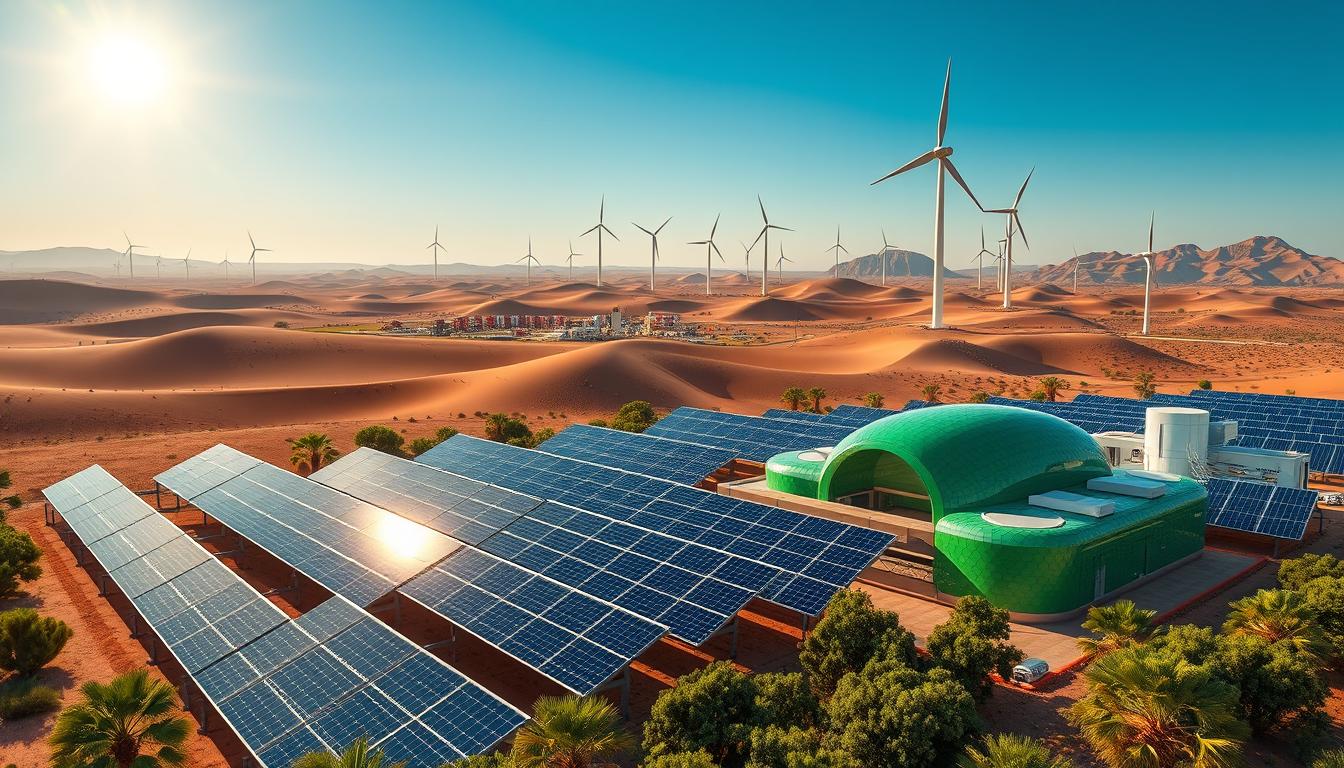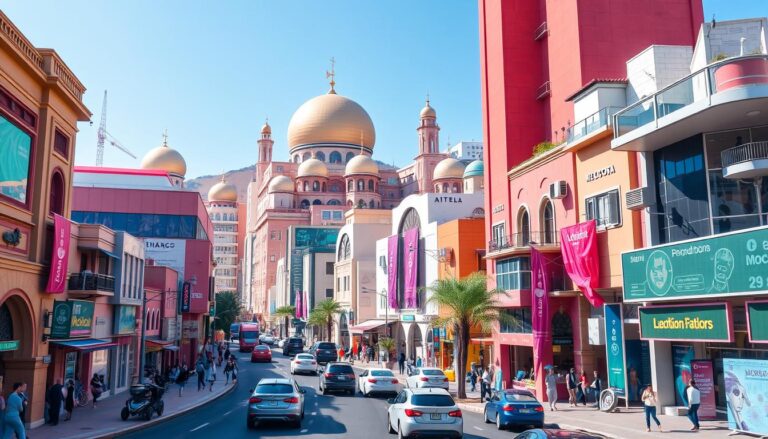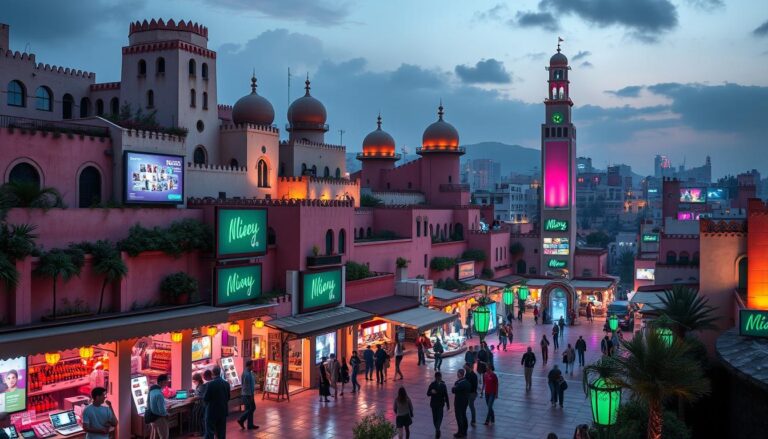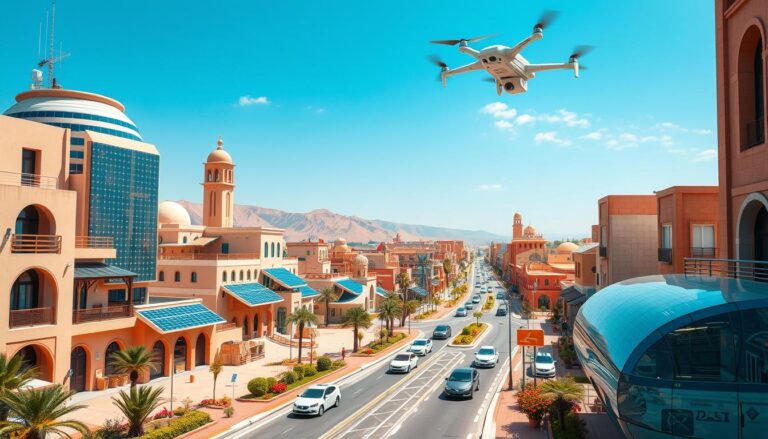Can Morocco turn its huge renewable energy into a green hydrogen leader? This could change the energy world, both locally and globally.
Morocco is leading the way in clean energy, thanks to a global push for sustainability. The country wants to cut down on greenhouse gases. It’s focusing on green hydrogen, using solar and wind power like the Noor Ouarzazate Solar Complex and Tarfaya Wind Farm.
Morocco plans to make renewable electricity into products like hydrogen, ammonia, and methanol. This will make energy more secure at home and let Morocco sell it to Europe. For example, Total Energies is investing €9.4 billion to start making green hydrogen in 2027.
Morocco wants to grow its green hydrogen market to 4 TWh locally and 10 TWh for exports by 2030. It needs 6 GW of new renewable energy and aims to create over 15,000 jobs. By 2050, green hydrogen demand could hit 307 TWh, and Morocco wants a big piece of that market.
Introduction to Green Hydrogen in Morocco
Green hydrogen is key in the search for clean energy solutions. It’s made by splitting water using renewable energy, leaving only heat and water vapor behind. This makes it different from traditional hydrogen, which uses fossil fuels. Morocco is a major player in this field, thanks to its natural resources, infrastructure, and location.
What is Green Hydrogen?
Green hydrogen comes from splitting water with solar or wind power. It doesn’t produce greenhouse gases, unlike traditional methods. Morocco plans to use 52% of its electricity from renewables by 2030. This makes it a leader in hydrogen production in North Africa.
The National Hydrogen Commission expects a big demand for it. They project 30 TWh by 2030 and 307 TWh by 2050. This shows Morocco’s big plans for this clean energy.
Why Morocco for Green Hydrogen?
Morocco is great for green hydrogen projects for several reasons. It has lots of solar and wind power, perfect for big renewable energy projects. The country also has good infrastructure, like a top 20 global port and a wide network of roads and rails.
The government has set aside one million hectares for green hydrogen projects. By 2024, 300,000 hectares will be ready for investors. This shows Morocco’s commitment to green hydrogen.
Morocco also has strong partnerships for green hydrogen. It works with Germany and gets support from the European Investment Bank. These partnerships help lower costs and improve efficiency. Morocco is building a strong base for the green hydrogen sector, ready for growth.
Morocco’s Green Hydrogen Vision
Morocco is leading in eco-friendly developments in green hydrogen. It’s becoming a key player in the Africa hydrogen economy. With lots of renewable energy, Morocco can make big changes in industries and help the world go green.
Economic and Industrial Sector Goals
Morocco wants to make hydrogen, ammonia, and methanol to cut down on greenhouse gases. By 2030, it plans to have a local hydrogen market of 4 TWh and export 10 TWh. This will create 15,000 jobs and help the economy.
It aims to take 4% of the global green hydrogen market by 2030. This could be 13.9 TWh to 30.1 TWh. By 2050, it hopes to capture up to 307 TWh. These goals are part of Morocco’s plan to grow its economy and be energy independent.
Consolidating Energy Transition
Morocco is all in on a green energy future. It uses solar and wind to meet over 4% of global green hydrogen demand by 2030. Big investments are being made, like Total Energies’ €9.4 billion project to make 10 GW by 2027.
The German Moroccan Energy Partnership (PARMA) is also supporting Morocco with €300 million. This money will help get green hydrogen from Morocco. Morocco’s work on energy transition is getting a boost from these investments and plans.
It’s building a national network of hydrogen and gas pipelines. It’s also setting aside over a million hectares for green hydrogen projects. These steps are key to Morocco’s role in the Africa hydrogen economy and its green future.
The National Green Hydrogen Strategy
Morocco has set a big goal for green hydrogen by 2030 and 2050. The National Hydrogen Commission, formed in 2019, has a plan. It focuses on three main areas: market, technology, and investment.
This plan wants to make Morocco a big player in green hydrogen. It aims to make production cheaper and attract more investment. This will help in making sustainable energy projects more appealing.
Roadmap Overview
Morocco wants to use its renewable energy to make a lot of green hydrogen. The goal is to reach 2 GW production. This will make Morocco competitive in the global market for green hydrogen.
Development Phases
The strategy is divided into three phases:
- Short-term: First, there will be pilot projects. These will be funded by the government and international groups. They will test new technologies and improve production.
- Medium-term: Next, the focus will be on scaling up. This will include making production more efficient and looking at costs. It will also help in exporting more green hydrogen.
- Long-term: Finally, Morocco will use green hydrogen in many areas. This includes transportation, farming, and industry.
In the future, Morocco plans to use new technologies to lower costs. This will help green hydrogen projects compete with other energy sources worldwide.
Market Demand and Export Potential
Morocco is focusing more on green hydrogen as climate change and energy sustainability become key issues. The country wants to make 10 GW of renewable energy by 2030. This will help produce up to 1 million tonnes of green hydrogen every year.
Morocco has big plans for renewable energy. It aims to increase its renewable energy from 37% to 52% by 2030. By 2040, it wants to reach 70%, and by 2050, 80%.
Local and International Markets
By 2030, Morocco’s green hydrogen demand is expected to hit a high mark. It will serve both local and international markets. The local market will need 4 TWh, while exports could reach up to 10 TWh.
By 2030, Morocco’s green hydrogen and derivatives industry could meet demand between 13.9 TWh and 30.1 TWh. This could grow to 307.1 TWh by 2050.
To produce and export green hydrogen, Morocco needs to invest in renewable energy and infrastructure. This will boost the local economy and create over 15,000 jobs. Morocco has a lot of renewable resources, including 25,000 MW of wind energy and 5,000 TWh/year of solar power over 700,000 km².
Infrastructure Requirements
Morocco needs to expand its sustainable energy infrastructure to meet demand and export green hydrogen. It must develop maritime transport, improve ports, and enhance production and storage facilities. Key projects include increasing wind energy and solar power, like the 300 MW Tarfaya wind farm and the 580 MW Noor Ouarzazate solar complex.
The success of Morocco’s green hydrogen strategy depends on implementing these infrastructure projects well. This will help it integrate into local and international markets. Morocco aims to become a global leader in renewable hydrogen exports.
Major Green Hydrogen Projects in Morocco
Morocco is leading the way in clean energy with big green hydrogen projects. The “GreenH2A: Green Hydrogen & Applications Park” is a key example. It focuses on green technologies like hydrogen, ammonia, and synthetic fuels.
The National Office of Hydrocarbons and Mines (ONHYM) is also exploring natural hydrogen. They found it in two big areas. This could greatly increase Morocco’s hydrogen supply.
Morocco has set up the Hydrogen Cluster to help the green hydrogen sector grow. It aims to connect industry players better. This will make the hydrogen ecosystem stronger and more united.
- Morocco wants to have a local hydrogen market of 4 terawatt hours (TWh) and export 10 TWh by 2030. They plan to build 6 GW of new renewable capacity and create over 15,000 jobs.
- TotalEnergies will invest €9.4 billion in a green hydrogen and green ammonia project in the Guelmim-Oued Noun region. This will make Morocco a top player in clean energy.
- By 2030, Morocco hopes to take up to 4% of the global green hydrogen market. This market is expected to be around 20,000 TWh.
Investments from the European Investment Bank (EIB) and Moroccan banks are also key. The EIB has invested €2.5 billion between 2017-2022. 20% of this went to renewable energy, showing their support for Morocco’s green goals.
Pioneering Green Energy Initiatives
Morocco is leading the way in renewable energy, using wind and solar power for new projects. The GreenH2A initiative is a key part of this effort. It focuses on green hydrogen technology and building a strong hydrogen sector.
GreenH2A: Green Hydrogen & Applications Park
GreenH2A aims to build a Green Hydrogen & Applications Park. It’s backed by IRESEN, OCP Group, and UM6P. The park will have a pilot unit that makes 4 tonnes of green ammonia daily.
It will use Power-To-X technologies, including 4MW of electrolysis. This facility is set to start by 2023, playing a big role in Morocco’s hydrogen sector.
The project will use up to 300,000 hectares for green hydrogen. It’s part of Morocco’s plan to boost renewable energy, create jobs, and drive innovation.
Natural Hydrogen Exploration
Morocco is also exploring natural hydrogen. The National Office of Hydrocarbons and Mines (ONHYM) is leading this effort. Finding natural hydrogen could help Morocco’s renewable energy projects even more.
Surveying and using natural hydrogen is a big part of Morocco’s green energy plan. It shows the country’s commitment to a diverse renewable energy mix. This is key for reducing greenhouse gases and fighting climate change.
These efforts show Morocco’s strong commitment to green hydrogen and sustainable energy. With its rich resources and innovative spirit, Morocco is set to change the global energy scene.
Partnerships and Investments
Morocco is working hard on green hydrogen thanks to green technology partnerships and big investments in sustainable energy infrastructure. These efforts help the country move towards cleaner energy and grow its economy.
German Moroccan Energy Partnership
The German Moroccan Energy Partnership (PARMA) is key for Morocco’s green hydrogen goals. It has a €300 million plan to boost the green industry by 2050. Morocco wants to lead in green hydrogen production with these big investments.
Total Energies Project
Total Energies is leading a big green hydrogen project in Morocco. It plans to start a green hydrogen plant in 2027, using 10 GW of clean electricity. This project shows how important green technology partnerships and investments in sustainable energy infrastructure are for Morocco.
The Moroccan government is also working hard. It’s finding land for green hydrogen projects. The goal is to use 1 million hectares, starting with 300,000 hectares. This will help big projects happen with the help of public and private partnerships.
Investors will get tax and customs breaks, making Morocco a great place for green tech investments. These partnerships are crucial for advancing technology and building the needed infrastructure. Things like power grids and ports are essential for green hydrogen projects to succeed in Morocco.
Policy and Regulatory Framework
The Moroccan government has set up strong policies for renewable energy, focusing on green hydrogen. These policies were announced in March 2024. They are key for Morocco’s energy plans and to attract both local and international investors.
Government Initiatives and Support
The government has set aside about one million hectares for green hydrogen production. They divided the land into plots of 10,000 to 30,000 hectares. This is to speed up project development.
The Morocco Offer aims to boost the country’s green hydrogen setup. It includes port facilities, hydrogen pipelines, water, and electricity grid upgrades.
The government aims to finish land contracts by Q3 2024. Then, they will have an eighteen-month design phase before making a final investment decision. Project proposals will be judged on technical, financial, and environmental factors. The government also wants to see local benefits and financial gains for Morocco.
Regulatory Challenges
Despite the big plans, Morocco faces regulatory hurdles. It lacks a clear framework for hydrogen production facilities. This includes safety, reporting, and licensing rules.
Morocco’s energy rules need to match international standards. They must follow European guidelines and the Carbon Border Adjustment Mechanism (CBAM). Working with countries like France and Germany will help Morocco become a green hydrogen leader.
Economic and Environmental Impact
Morocco is working hard to become greener. The green hydrogen industry is leading this effort. It will help the economy grow and create many jobs. By 2030, over 15,000 jobs could be made, helping Morocco’s economy a lot.
Morocco wants to use more renewable energy, aiming for over 52% by 2030. By 2020, it had nearly 3.5 GW of renewable energy. This growth is key to reducing energy imports and joining the global green energy market.
Job Creation and Economic Growth
Green hydrogen will create thousands of jobs. These jobs will be in making hydrogen and in the supply chain. Economic growth through sustainable development is clear as this industry creates jobs and boosts other sectors like transport and manufacturing.
Morocco is working with groups like IRENA and the European Commission. They are setting up policies and studies to help hydrogen trade grow. This will help Morocco and the region.
Environmental Benefits
Green hydrogen is very good for the environment. It’s a clean alternative to traditional hydrogen, which pollutes a lot. Green hydrogen is made by using renewable energy to split water, leaving only water vapor behind.
Green hydrogen will help big polluters like transport and steel industries. By using green hydrogen, Morocco will meet global climate goals. This will make the air cleaner for future generations.
Morocco is leading in renewable energy with green hydrogen. It shows the country’s goal to use sustainable energy and grow its economy in a green way.
Conclusion
Morocco is deeply committed to green hydrogen, showing a strong will for change and leadership in energy. It uses lots of renewable resources to aim for a future without carbon. This effort sets high standards for clean energy worldwide, thanks to partnerships and policies.
The country has made big strides in power generation and storage, showing it’s serious about energy and the environment. It’s getting help from around the world and has big plans, like sending 115 TWh of green hydrogen by 2050. This will make a big difference in markets everywhere.
But, there are hurdles like tech challenges and needing a lot of money. Still, Morocco’s good climate for renewables and its location near Europe make it a key player. It’s working hard to grow its economy, create jobs, and lead the way to a green energy future.
Source Links
- Morocco
- Morocco and the Future of Green Hydrogen
- MASEN – Offre Maroc Hydrogène Vert
- Morocco’s emergence as a green hydrogen leader – African Association of Entrepreneurs
- The EIB and the Future of Green Hydrogen in Morocco: Interview with Adrien de Bassompierre
- A Critical Analysis of Morocco’s Green Hydrogen Roadmap: A Modelling Approach to Assess Country Readiness from the Energy Trilemma Perspective
- Morocco’s green hydrogen offer and opportunities for investors
- Morocco – Energy
- * | Latest Market News | Argus Media
- Financing Green Hydrogen Projects in Morocco and Chile – REGlobal – Finance
- Morocco’s Strategic Move in the Green Hydrogen Sector: Unveiling the "Morocco Offer"Article
- Morocco’s Revolutionary Green Hydrogen Offer – CASCI
- Green Hydrogen in Morocco: Pioneering Projects and Advancements – Green Hydrogen
- Morocco: Green hydrogen – the Moroccan Offer
- OCP & Fortescue to partner in green energy, hydrogen and ammonia in Morocco
- Green Hydrogen market in Morocco: needs and barriers
- Morocco and IRENA Partner to Boost Renewables and Green Hydrogen Development
- Green Hydrogen: The Future of the Global Energy Transition? | Heinrich-Böll-Stiftung | Tel Aviv – Israel
- How Can Moroccan SMEs Participate in the Green Hydrogen Revolution?

The Editorial Team is a passionate group of Morocco enthusiasts dedicated to sharing the beauty, culture, and wonders of this captivating country. With diverse backgrounds and a deep love for travel, we strive to bring you engaging and informative content that inspires your Moroccan adventures. From uncovering hidden gems and sharing local insights to exploring mouthwatering cuisine and showcasing the vibrant lifestyle, our team is committed to providing you with valuable resources and exciting stories that enhance your exploration of Morocco. Join us on this journey as we celebrate the rich heritage and unforgettable experiences that make Morocco truly special.





